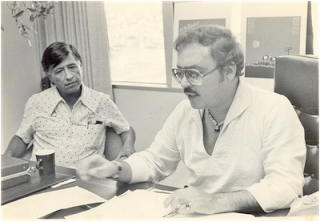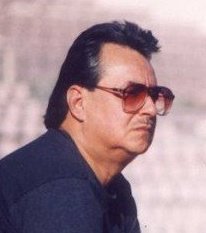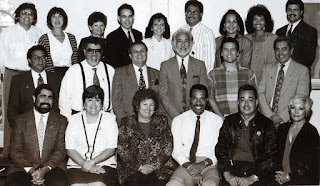The tape contains music and interviews with Chicano rock pioneers TIERRA,
YAQUI, Mark Guerrero and Chicano rock music producer, Art Brambila, which aired
40 years ago on KLOS-FM in Los Angeles, CA.
Memories,
precious memories!
There isn’t a Chicano alive today who doesn’t recognize the title of the 1980 hit record made famous by the legendary East Los Angeles-based Chicano rock group, TIERRA!
There isn’t a Chicano alive today who doesn’t recognize the title of the 1980 hit record made famous by the legendary East Los Angeles-based Chicano rock group, TIERRA!
Little did most Chicano rock music devotees and aficionados know that TIERRA
actually recorded an album almost ten years before its giant “Memories” hit that,
which, for the most part, contained and important message about the Chicano
culture, with original music that has become the standard sound that epitomizes
the indeginous East Los Angeles music style, which combines a unique blend of
rock, soul, R & B, salsa and Latin Jazz.
Well, lo and behold, a rare radio show that showcased
TIERRA’s music along with other pioneers of that unique musical sound, has been
discovered and it includes an interview and the music of the person who found
the tape among others loaned to him by friend and former manager, Chicano music
producer, Art Brambila.
“I was simply going through some old reel to reel tapes in an old box that Art loaned me a couple of years ago, looking for material to add to my
Chicano music history web site, “ said Mark Guererro, a veteran
singer-songwriter who hosts a web site that probably contains more information
about Chicano music artists than anyone else in the world.
"When I started playing this one tape, I couldn't believe what I was hearing,"Guerrero said.
"When I started playing this one tape, I couldn't believe what I was hearing,"Guerrero said.
The tape that Guerrero found contained a recording of a
show on KLOS-FM radio station in Los Angeles where he was interviewed in 1972 by
Joe Ortiz, Chicano talk show host pioneer, along with members of Chicano Rock
band legends TIERRA and YAQUI and their manager, Art Brambila.
“Here I sat, stunned, listening
to my song I'm
Brown and being interviewed on a radio show that was
broadcast 40 years ago,” said Guerrero.
After listening to the entire show, Guerrero quickly
got on the phone and called Ortiz, a close friend since they met back in 1972
when he appeared on Ortiz’ television show on Channel 2, The Siesta is Over, a month before the radio interview. Guerrero
also quickly called Art Brambila, who was the president of Brown Bag
Productions, who produced his song as well as the first albums for TIERRA and YAQUI
forty years ago. Guerrero told both Brambila and Ortiz that he would email them
a copy of the show as soon as he was finished dubbing the tape into MP3 format.
“I have many tapes of radio interviews I conducted on
my shows in the mid 80’s to the 90’s, said Ortiz, “but nothing going back to
the days when I first began working as a talk show host in 1971 at KABC-AM, and
then the following year at its sister station, KLOS-FM. This interview that
Mark discovered is like finding a golden nugget in the penny jar of Chicano
rock music history.”
Ortiz added that the few Chicano broadcasters they had
back in the days before digital video and audio were too focused on taking
advantage of the few media venues available to them to think about recording
the historical relevance those interviews represented in the late 60’s and
early 70’s. “But, obviously someone recorded that show unbeknownst to me and
the guests on the show.”
“After listening to the MP3 Mark sent me, I called him
and Art and told them that they may not realize it, but that show is probably
the only interview in existence where these visionary musicians were presenting the American
audience with the most intelligent and profound expression of what has become
an indigenous musical genre that has touched the lives of most Latinos
throughout the world. “
Most certainly, Brambila has always had a dream and a
vision about the unique sounds he grew up with on Clover Street in the Lincoln
Heights area of East Los Angeles, the same community where his nephews Rudy and
Steve Salas, the founders of TIERRA, were raised, along with Eddie Serrano of
YAQUI.

(Cesar Chavez, founder of the United Farm Workers of
America,
listens to songwriter Art Brambila’s lyrics of the song he wrote for
the organization called Manana is Now,
circa 1976)
“I
have always known that we (Chicanos) had great talent in all areas, especially
in the music field, “said Brambila, who later in his career launched a
television show in the late 70’s called The
Mean Salsa Machine, the
first bi-lingual major market TV show on an English Speaking station, Channel 9,
in Los
Angeles. Brambila also excelled as a songwriter himself with a tune he penned, Mañana Is Now , for the album Si Se Puede, the 1976 charity album debut of Los Lobos, of which the
proceeds from the album went towards the United Farm Workers of America.
(Original cover of TIERRA’s first album, autographed
for Joe Ortiz
by the original members, which he still has in his possession)
“When
I first started managing these gifted musicians, I knew they had a unique and
marketable sound that would revolutionize the recording industry,” said
Brambila, who had
much experience in the marketing division at Capitol Records, but little
technical in studio experience, but I used that knowledge to promote these
talented guys,” added Brambila. His efforts resulted in Mark Guerrero, TIERRA and
YAQUI signing a contract with major labels Capitol Records, 20th
Century and Playboy, respectively.
Although Brambila’s vision was being fulfilled during
those early and trying times, he knew this evolution from being mere Chicano
music performers would one day not only touch the hearts of Chicano audiences
throughout the southwest, but the heartfelt message about Chicanos and their
culture would soon provide the predominate community with crucial and
insightful messages they needed to hear.
“When I first heard about Joe’s radio show, we contacted
his producer, Luis Torres, and he booked my guys (TIERRA, YAQUI and Mark
Guerrero) right away, said Brambila.”
Joe
Ortiz (center) with the founders of TIERRA, the Salas Brothers (Steve on the left
and Rudy far right)
Ortiz, the first Mexican American to conduct a radio
show on an English-language commercial radio station, was known best for promoting
enterprising Latinos, groups and organizations on his shows.
“When Joe told us no one had ever discussed nor had
heard the history behind this unique emerging Chicano rock sound on American
airwaves, little did we realize that the predominately white KLOS-FM audience,
was being introduced to the Eastside Sound
for the very first time,” added Brambila.
“Mark, Art, Eddie, Steve and all the guys poured out
their heart and soul that evening, providing our listeners with information
they had never heard before,” said Ortiz. “The intelligent and easy to
understand manner in which they conveyed the cultural nuances of Chicano rock
music was like listening to music professors giving a lecture to their students
at a major university.”
Ortiz said those who listen to the tape will be moved
by the phone-in callers and their intelligent questions, KLOS audience members who
genuinely were captivated by the sound and wanted to know more about the music’s
history and inspiration.
While the birth of Chicano music goes back to the early 20th
century, it began a unique and evolutionary transition in the late sixties,
spurned by the Chicano Civil Rights movement. Besides the traditional I love you baby tunes that many Chicano
musicians were playing in the late fifties and early sixties, this new and
emerging Chicano rock music contained
and was delivering messages in a Dylanesque motif about the lives, hopes and
aspirations of Mexican Americans in the greater Los Angeles area.
(Mark Guerrero and his
brother Dan chat with Bill Clinton after the President bestowed the National
Medal of Arts to their father, Chicano music icon, Lalo Guerrero, at the White
House)
“Mark Guerrero’s involvement with Chicano music began right
before that era, and much of his heart and soul for this genre is historical
and runs deep,” said Ortiz. “It’s obvious he was influenced to a great degree
by his father, Lalo Guerrero, who is recognized as the Father of Chicano music.”Yet, Mark developed his own unique style, which is still evolving; but he does credit Chicano Study classes at Cal State Los Angeles and his father for instilling in him unique pride in his Chicano heritage.
Prior to his death on March 17, 2005, Lalo Guerrero, the iconic Chicano music hero was presented the National Medal of Arts by then President Bill Clinton for a lifetime of achievements, the only Chicano to receive our nation’s highest arts award.
(Mark
Guerrero singing I’m Brown
The newly found Lost KLOS Interview with Mark Guerrero and Latino Legends starts
off with Mark’s recording of I'm Brown,
of which the lyrics bespeaks his passion for music, the emerging Chicano
culture of that era, and its demand for respect.
(Yaqui
members, left to right, Rudy Regalado, Larry
Cronen, Ray Rodriguez, Eddie Serrano and Ronnie Reyes. Squatting left to right,George Ochoa and Art Sanchez)
The tape also features YAQUI lead singer George Ochoa’s
rendition of “Brown Baby” which also cries out the heart and soul of a Chicano
culture indigenous to the East Los Angeles Mexican American community. One of the group’s original tunes and one of
its biggest hits (before Barack Obama capitalized on the slogan) was It's
Time For a Change.
"It's Time for a Change (Tiempo Para Un
Cambio)," which shows all three artists on Brown Bag Productions, were also
writing and recording socially relevant music,” said Guerrero. “That song
appeared on a compilation in the 90s called "Ay Califas- Raza Rock"
(1998) and has also been recorded by Tierra on their latest CD.”
Eddie Serrano (since passed away) left YAQUI and later
became the lead singer for another famous Chicano rock group, Cannibal and the
Headhunters, which gained international acclaim for their mega hit,
Land
of a 1000 Dances.
The tape, which did not have the traditional introduction that normally opened Ortiz’ radio shows, also does not have a closing segment. Mark told Joe the tape was so old that parts of it were practically glued together and he didn’t want to chance destroying it by pulling it apart. Nevertheless, the tape ends with TIERRA's original tune called Barrio Suite, a seven and a half minute musical anthology that virtually encapsulates the Chicano cultural ethos.
The tape, which did not have the traditional introduction that normally opened Ortiz’ radio shows, also does not have a closing segment. Mark told Joe the tape was so old that parts of it were practically glued together and he didn’t want to chance destroying it by pulling it apart. Nevertheless, the tape ends with TIERRA's original tune called Barrio Suite, a seven and a half minute musical anthology that virtually encapsulates the Chicano cultural ethos.
(Steve Salas being interview by Joe Ortiz on KLOS-FM)
“To me, personally, Barrio Suite and I'm Brown are probably the two most profound Chicano tunes ever written,” said Brambila.
“Mark’s
message in I'm Brown speaks
of the deep-seeded feeling most Chicanos have about their community. Rudy and
Steve Salas and the members of TIERRA at that time produced in Barrio Suite a seven and a half minute musical train that takes the
listener on a musical Mexican American culture journey through the barrios of
East Los Angeles.”
TIERRA
“These talented musicians are still going strong, after
the forty intervening years, from when that unique interview show aired,” said
Ortiz. “TIERRA and Mark are still the poet laureates of the Chicano experience
they were back then, and very few if any new Chicano musicians, will ever
duplicate their historical work.”
(Left to right, Mark Guerrero and Art Brambila, and Joe
Ortiz in the background, meet at Las Fuentes Restaurant in Redlands, CA to discuss what to do with the tape)
Having found this rare tape, the three discussed the historical and educational significance of the show and what they wanted to do with it. They all agreed the tape represents a significant piece of Chicano rock history and that they should at least post it on their respective web sites for fans to download and hear the tape, and also send it out to as many Chicano media and web sites they could find.
Having found this rare tape, the three discussed the historical and educational significance of the show and what they wanted to do with it. They all agreed the tape represents a significant piece of Chicano rock history and that they should at least post it on their respective web sites for fans to download and hear the tape, and also send it out to as many Chicano media and web sites they could find.
“At the least, for thousands of Chicano rock music fans
who listen to this rare interview tape, it seems to me it will definitely bring back many
precious memories!”
~
The 50 minute KLOS-FM interview tape will also be available for those who want
to hear or download the show on the Mark Guerrero web
site, which also contains the most comprehensive information on the Internet about
Chicano music, its birth and evolution throughout the last 50 years.




























.jpg)


























.jpg)


















2 comments:
Post a Comment